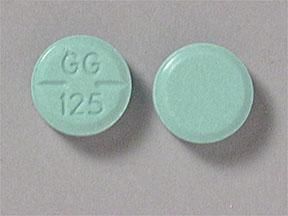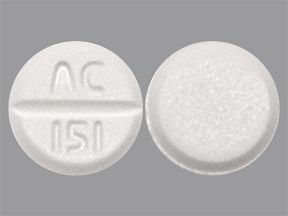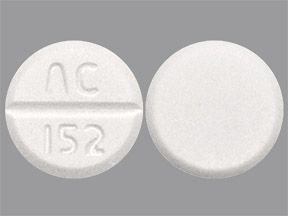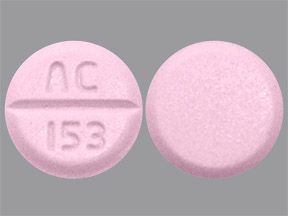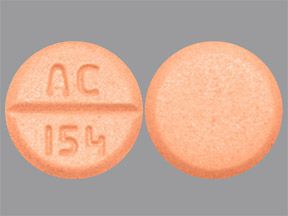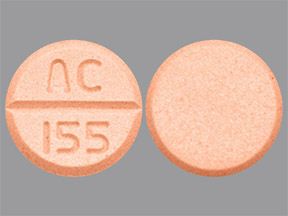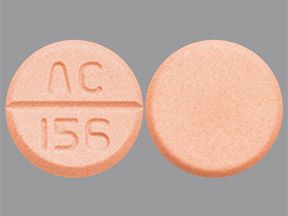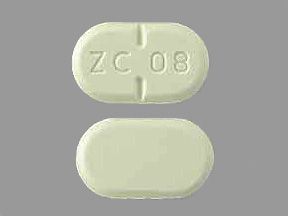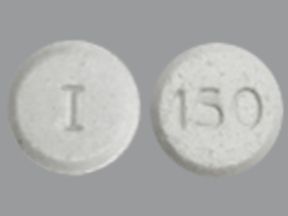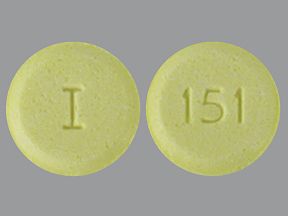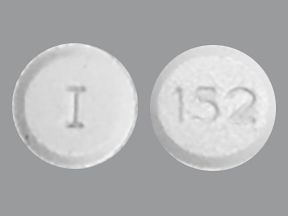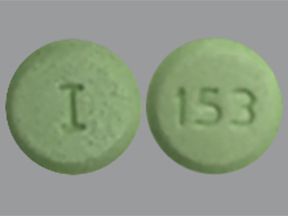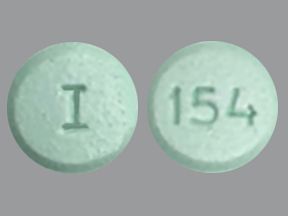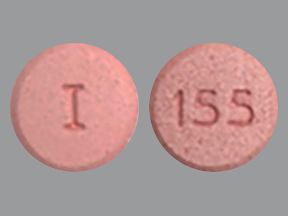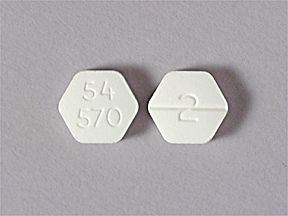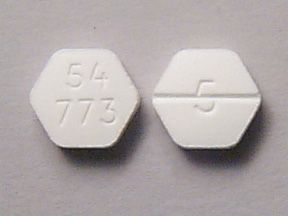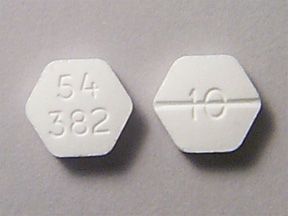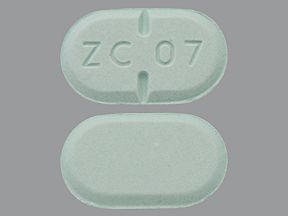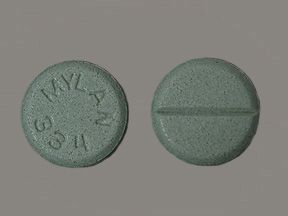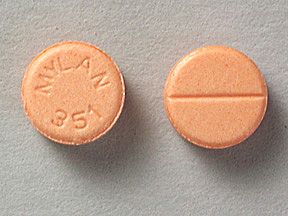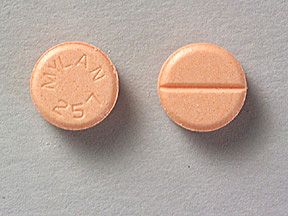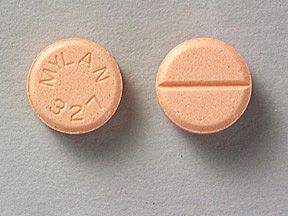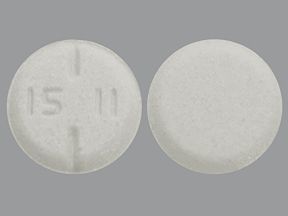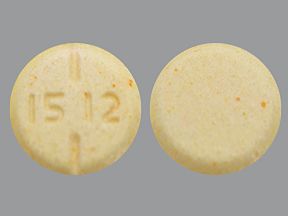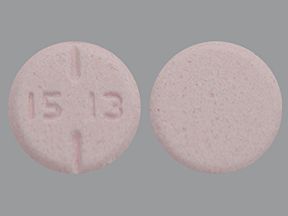Highlights for haloperidol
- Haloperidol oral tablet is only available as a generic drug. There is no brand-name version.
- Haloperidol is available as an oral tablet, an oral solution, and an injectable form.
- Haloperidol oral tablet is used to treat a range of disruptive disorders, behavior problems, and motion problems.
FDA warning: For people with dementia
- This drug has a black box warning. This is the most serious warning from the Food and Drug Administration (FDA). A black box warning alerts doctors and patients about drug effects that may be dangerous.
- If you’re aged 65 years and older and have dementia that’s causing psychosis, taking haloperidol may increase your risk of death.
Other warnings
- Neuroleptic malignant syndrome: Haloperidol may cause a severe reaction called neuroleptic malignant syndrome. This occurs due to haloperidol’s interference with dopamine. Symptoms may include fever, rigid or stiff muscles, changed mood, irregular pulse or blood pressure, fast or irregular heartbeat, and unexplainable sweating. If you experience these symptoms, stop taking haloperidol right away and get medical help. This syndrome can damage your muscles and kidneys.
- Movement symptoms: Haloperidol may trigger extrapyramidal symptoms. These include involuntary movements, such as hand tremor and shaking, stiff and slow movements, agitation or restlessness, and muscle spasms. These symptoms often happen during the first few days of taking haloperidol. You’re at increased risk if you’re a young man or you take high doses of haloperidol. If you experience these symptoms, your doctor might change your dose or add medications like benztropine or trihexyphenidyl to treat the extrapyramidal symptoms.
- Q-T syndrome: Haloperidol use may trigger Q-T syndrome. This condition can lead to an irregular heart rate called torsades de pointes, which can be fatal. You’re at higher risk of this if you take more than the recommended dose. You’re also at higher risk if you have low potassium or magnesium levels, preexisting heart conditions, low thyroid function, or a family history of long QT syndrome.
- Dementia warning:
Research has indicated that this type of medication can cause effects similar to those caused by drugs called anticholinergics. This can raise your risk of dementia.
Haloperidol is a prescription drug. It comes as an oral tablet and a concentrated oral solution. It also comes in an injectable form, which is only given by a healthcare provider.
Haloperidol oral tablet is available only as a generic drug. Generic drugs usually cost less than brand-name drugs.
Why it’s used
Haloperidol is used to treat a range of disruptive disorders, behavior problems, and motion problems. It’s approved to treat:
- manifestations of psychotic disorders
- control of facial muscle spasms (tics) and voice disturbances of Tourette syndrome
- severe behavior problems in children with combative, explosive hyperexcitability
- hyperactive children who show excessive activity with accompanying conduct disorders
Using this medication for children should be considered only after psychotherapy and other medications have failed.
How it works
Haloperidol belongs to a class of drugs called antipsychotics. A class of drugs is a group of medications that work in a similar way. These drugs are often used to treat similar conditions.
Antipsychotics act on the brain chemical dopamine. Decreasing dopamine may help treat psychosis.
Haloperidol may also weakly block actions of other brain chemicals. This may help to manage aspects of certain mental disorders, such as combativeness, explosiveness or over-excitability, excessive movement, impulsiveness, trouble paying attention, and mood swings.
Haloperidol oral tablet can cause drowsiness. It can also cause other side effects.
More common side effects
The more common side effects that can occur with haloperidol include:
- central nervous system effects, including:
- anxiety or agitation
- tiredness
- trouble sleeping
- gastrointestinal effects, including:
- constipation or diarrhea
- nausea or vomiting
- hormonal effects, including:
- decreased sexual ability
- monthly menstrual cycle changes
- increased prolactin levels
- anticholinergic effects, including:
- dry mouth
- blurred vision
- weight gain
- reduced sensitivity to heat or cold
Serious side effects
Call your doctor right away if you have serious side effects. Call 911 if your symptoms feel life-threatening or if you think you’re having a medical emergency. Serious side effects and their symptoms can include the following:
- breast pain and swelling, or unusual production of breast milk (women only)
- trouble passing urine, or sudden loss of bladder control
- dizziness or light headedness
- fever, chills, or sore throat
- hot, dry skin, heat stroke, or lack of sweating
- seizures
- skin rash
- movement (extrapyramidal) symptoms such as:
- stiffness, spasms, or trembling
- slow movement
- agitation or restlessness
- abnormal muscle tone
- twisting movement of your head, neck, or tongue
- tardive dyskinesia, a movement problem with symptoms such as:
- uncontrollable tongue or chewing movements, smacking lips, or puffing cheeks
- persistent uncontrollable movements in your legs
- dystonia (abnormal movement and prolonged contractions caused by disordered muscle tone), with symptoms such as:
- uncontrollable muscle spasms in your face, hands, arms, or legs
- twisting body movements
- trouble breathing
- difficulty in speaking and swallowing
- loss of balance or difficulty walking
- cardiovascular effects, including:
- low blood pressure
- irregular heart beat
- fatigue
- jaundice, with symptoms such as:
- yellowing of your skin or the whites of your eyes
- lung infection called bronchopneumonia
Disclaimer: Our goal is to provide you with the most relevant and current information. However, because drugs affect each person differently, we cannot guarantee that this information includes all possible side effects. This information is not a substitute for medical advice. Always discuss possible side effects with a healthcare provider who knows your medical history.
Haloperidol oral tablet can interact with other medications, vitamins, or herbs you may be taking. An interaction is when a substance changes the way a drug works. This can be harmful or prevent the drug from working well.
To help avoid interactions, your doctor should manage all of your medications carefully. Be sure to tell your doctor about all medications, vitamins, or herbs you’re taking. To find out how this drug might interact with something else you’re taking, talk to your doctor or pharmacist.
Examples of drugs that can cause interactions with haloperidol are listed below.
Bipolar disorder drug
Using lithium with haloperidol can lead to encephalopathic syndrome. This condition can result in brain damage. Symptoms may include weakness, fever, tremor, confusion, muscle spasms, and abnormal blood test results. If you experience any of these symptoms, tell your doctor right away.
Irregular heart rate drugs
Don’t take haloperidol with these drugs. The combination can increase the effects that both drugs may have on your heart. This can cause the irregular heart rate called torsades de pointes, which can be fatal. Examples of these drugs include:
- dofetilide
- quinidine
- dronedarone
Anticoagulant, blood thinner
Taking warfarin with haloperidol may make warfarin less effective.
Parkinson’s disease drugs
Taking haloperidol with these medications can make the Parkinson’s medications less effective. It may also increase pressure of the fluid in your eyes. If you’re taking these drugs together and they need to be stopped, the haloperidol should be stopped first to prevent muscle side effects. Examples of these drugs include:
- levodopa
- pramipexole
- ropinirole
Anti-seizure drugs
Haloperidol increases your risk of seizure. Your doctor should use caution in prescribing haloperidol for you if you’re taking anti-seizure drugs. Examples of these drugs include:
- carbamazepine
- phenytoin
- valproic acid
- oxcarbazepine
Antibiotic
Taking rifampin with haloperidol may lower the amount of haloperidol in your body. Your haloperidol dose may need to be changed or stopped when you start taking rifampin.
Low blood pressure drug
Taking epinephrine with haloperidol may block the action of epinephrine and cause a condition called epinephrine reversal. Symptoms of epinephrine reversal may include a serious decrease of blood pressure, fast heart rate, and heart attack.
Disclaimer: Our goal is to provide you with the most relevant and current information. However, because drugs interact differently in each person, we cannot guarantee that this information includes all possible interactions. This information is not a substitute for medical advice. Always speak with your healthcare provider about possible interactions with all prescription drugs, vitamins, herbs and supplements, and over-the-counter drugs that you’re taking.
This drug comes with several warnings.
Allergy warning
Haloperidol can cause a severe allergic reaction. Symptoms may include:
- trouble breathing
- swelling of your throat or tongue
- hives
If you develop these symptoms, call 911 or go to the nearest emergency room.
Don’t take this drug again if you’ve ever had an allergic reaction to it. Taking it again could be fatal.
Alcohol interaction warning
Avoid using alcohol while taking haloperidol. Drinking alcohol while taking haloperidol can make the side effects of both the drug and alcohol stronger. Taking alcohol and haloperidol together may also cause your blood pressure to decrease.
Warnings for people with certain health conditions
For people with dementia: If you’re aged 65 years or older and have psychosis related to dementia, taking haloperidol may increase your risk of death. You shouldn’t use haloperidol if you have this condition.
For people with cerebrovascular disease: These are serious diseases of the blood vessels to the heart and brain. Haloperidol may cause a temporary drop in blood pressure or cause chest pain. If you have symptoms of a drop in your blood pressure level, contact your doctor. Symptoms include:
- dizziness
- fainting
- blurred vision, especially when standing up
For people with seizures: If you have a history of seizures or are taking anti-seizure drugs, your doctor may lower your dose of haloperidol or stop your treatment with this drug. Taking haloperidol may make you have a seizure more easily.
For people with Parkinson’s disease: Haloperidol works on a chemical in your brain called dopamine. It may make your Parkinson’s disease much worse.
For people with low white blood cell counts: Haloperidol may cause the number of your white blood cells to drop. You doctor will need to check your white blood cell count often. If your blood cell counts become too low, you may have to stop taking haloperidol.
For people with mania: When haloperidol is used to control mania in mania cyclic disorder, you may have a fast mood swing to depression.
For people with thyrotoxicosis: This is a condition that happens when your body makes too much thyroid hormone. Too much thyroid hormone in your body can be toxic to your nervous system. Haloperidol may increase your chance of having this condition. Symptoms may include rigidity and the inability to walk and talk.
For people with low potassium or magnesium: Having low potassium or magnesium levels and taking haloperidol may increase your risk of cardiovascular side effects. These include Q–T syndrome and an irregular heart rate called torsades de pointes, which can be fatal.
Warnings for other groups
For pregnant women: There are no well-controlled studies with haloperidol in pregnant women. There are reports of birth defects, but it’s not certain if haloperidol was the cause.
You should only use haloperidol during pregnancy if the potential benefit outweighs the potential risk to the fetus.
Call your doctor if you become pregnant while taking this drug.
For women who are breastfeeding: Avoid breastfeeding while taking haloperidol. Haloperidol passes through breast milk and may harm your child.
For seniors: The effects of haloperidol in people aged 65 years and older may be much stronger.
Seniors are more at risk for a side effect called tardive dyskinesia. This condition can cause movement disorders of your mouth and legs. Women who have been taking this medication for a long time are at higher risk.
For children: Haloperidol is not approved for children younger than 3 years.
All possible dosages and forms may not be included here. Your dose, form, and how often you take it will depend on:
- your age
- the condition being treated
- how severe your condition is
- other medical conditions you have
- how you react to the first dose
Drug forms and strengths
Generic: Haloperidol
- Form: oral tablet
- Strengths: 0.5 mg, 1 mg, 2 mg, 5 mg, 10 mg, and 20 mg
Dosage for psychotic and behavioral disorders
Adult dosage (ages 18–64 years)
- Typical dosage: 0.5–5 mg, taken two to three times per day.
- Maximum dosage: 100 mg per day.
After your body reaches the desired response, your dosage should be gradually lowered to the lowest possible dosage that works for you.
Child dosage (ages 3–12 years and weighing from 15–40 kg)
Dosage is based on your child’s weight and condition.
- Typical dosage: 0.05–0.15 mg per kilogram of body weight per day.
After reaching the desired response, the dose should be gradually lowered to the lowest possible dose that works. Doses above 6 mg haven’t been proven to be effective.
Child dosage (ages 0–2 years)
A safe and effective dose hasn’t been established for children younger than 3 years old.
Senior dosage (ages 65 years and older)
- Recommended dosage: 0.5–2 mg two to three times per day.
After your body reaches the desired response, your dosage should be gradually lowered to the lowest possible dosage that works for you.
Disclaimer: Our goal is to provide you with the most relevant and current information. However, because drugs affect each person differently, we cannot guarantee that this list includes all possible dosages. This information is not a substitute for medical advice. Always speak with your doctor or pharmacist about dosages that are right for you.
Haloperidol is used for short-term or long-term treatment. It comes with risks if you don’t take it as prescribed.
If you stop taking the drug or miss doses: If you stop taking haloperidol, miss doses, or don’t take it on schedule, you may experience more symptoms caused by your condition.
If you take too much: You could have dangerous levels of the drug in your body. Symptoms of an overdose of this drug can include:
- weak or rigid muscles
- tremor
- low blood pressure
- severe sleepiness
- irregular heart rate
- shock-like state, with decreased breathing and loss of consciousness
If you think you’ve taken too much of this drug, call your doctor or seek guidance from the American Association of Poison Control Centers at 800-222-1222 or through their online tool. But if your symptoms are severe, call 911 or go to the nearest emergency room right away.
What to do if you miss a dose: If you miss a dose, take it as soon as you can. However, if it’s just a few hours until your next dose, only take one dose. Never try to catch up by taking a double dose. This could result in dangerous side effects.
How to tell if the drug is working: You should have fewer symptoms of your condition.
Keep these considerations in mind if your doctor prescribes haloperidol for you.
General
- Take this drug with food to help prevent upset stomach.
- You can cut or crush the tablet.
Storage
- Store this drug at room temperature between 68°F and 75°F (20°C and 24°C).
- Protect this medication from light.
- Don’t store this medication in moist or damp areas, such as bathrooms.
Refills
A prescription for this medication is refillable. You shouldn’t need a new prescription for this medication to be refilled. Your doctor will write the number of refills authorized on your prescription.
Travel
When traveling with your medication:
- Always carry your medication with you. When flying, never put it into a checked bag. Keep it in your carry-on bag.
- Don’t worry about airport X-ray machines. They won’t damage your medication.
- You may need to show airport staff the pharmacy label for your medication. Always carry the original prescription-labeled container with you.
- Don’t put this medication in your car’s glove compartment or leave it in the car. Be sure to avoid doing this when the weather is very hot or very cold.
Clinical monitoring
Your doctor may perform tests to check your health and make sure this drug is working for you. These include:
- blood test (complete blood count and prolactin level)
- eye exam
- urine test
Sun sensitivity
Haloperidol can make you more sensitive to the sun. Keep out of the sun. If you can’t avoid being in the sun, wear protective clothing and use sunscreen. Don’t use sun lamps or tanning beds.
Availability
Not every pharmacy stocks this drug. When filling your prescription, be sure to call ahead to make sure your pharmacy carries it.
Prior authorization
Many insurance companies require a prior authorization for this drug. This means your doctor will need to get approval from your insurance company before your insurance company will pay for the prescription.
There are other drugs available to treat your condition. Some may be better suited for you than others. Talk to your doctor about other drug options that may work for you.
Disclaimer: Healthline has made every effort to make certain that all information is factually correct, comprehensive, and up-to-date. However, this article should not be used as a substitute for the knowledge and expertise of a licensed healthcare professional. You should always consult your doctor or other healthcare professional before taking any medication. The drug information contained herein is subject to change and is not intended to cover all possible uses, directions, precautions, warnings, drug interactions, allergic reactions, or adverse effects. The absence of warnings or other information for a given drug does not indicate that the drug or drug combination is safe, effective, or appropriate for all patients or all specific uses.

